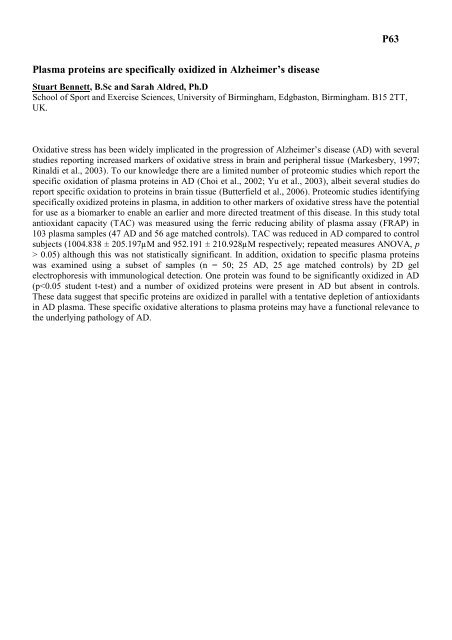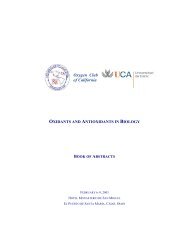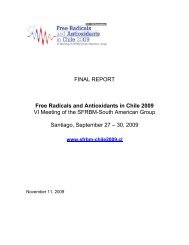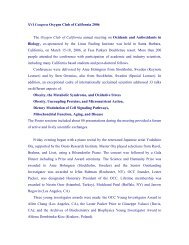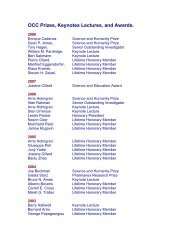PROGRAMME SCIENTIFIQUE - Oxygen Club of California
PROGRAMME SCIENTIFIQUE - Oxygen Club of California
PROGRAMME SCIENTIFIQUE - Oxygen Club of California
You also want an ePaper? Increase the reach of your titles
YUMPU automatically turns print PDFs into web optimized ePapers that Google loves.
P63<br />
Plasma proteins are specifically oxidized in Alzheimer’s disease<br />
Stuart Bennett, B.Sc and Sarah Aldred, Ph.D<br />
School <strong>of</strong> Sport and Exercise Sciences, University <strong>of</strong> Birmingham, Edgbaston, Birmingham. B15 2TT,<br />
UK.<br />
Oxidative stress has been widely implicated in the progression <strong>of</strong> Alzheimer’s disease (AD) with several<br />
studies reporting increased markers <strong>of</strong> oxidative stress in brain and peripheral tissue (Markesbery, 1997;<br />
Rinaldi et al., 2003). To our knowledge there are a limited number <strong>of</strong> proteomic studies which report the<br />
specific oxidation <strong>of</strong> plasma proteins in AD (Choi et al., 2002; Yu et al., 2003), albeit several studies do<br />
report specific oxidation to proteins in brain tissue (Butterfield et al., 2006). Proteomic studies identifying<br />
specifically oxidized proteins in plasma, in addition to other markers <strong>of</strong> oxidative stress have the potential<br />
for use as a biomarker to enable an earlier and more directed treatment <strong>of</strong> this disease. In this study total<br />
antioxidant capacity (TAC) was measured using the ferric reducing ability <strong>of</strong> plasma assay (FRAP) in<br />
103 plasma samples (47 AD and 56 age matched controls). TAC was reduced in AD compared to control<br />
subjects (1004.838 ± 205.197µM and 952.191 ± 210.928µM respectively; repeated measures ANOVA, p<br />
> 0.05) although this was not statistically significant. In addition, oxidation to specific plasma proteins<br />
was examined using a subset <strong>of</strong> samples (n = 50; 25 AD, 25 age matched controls) by 2D gel<br />
electrophoresis with immunological detection. One protein was found to be significantly oxidized in AD<br />
(p


